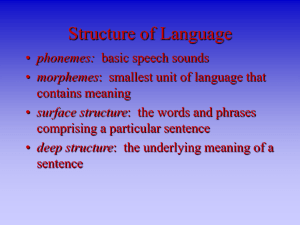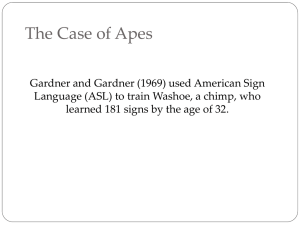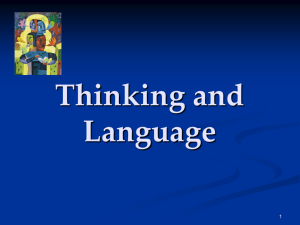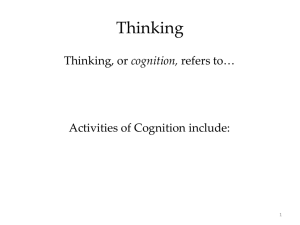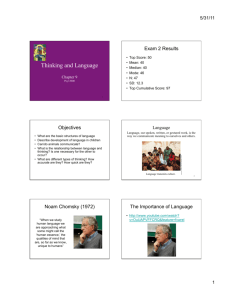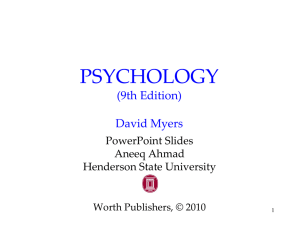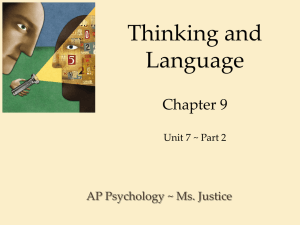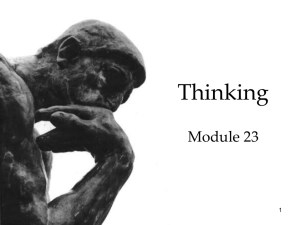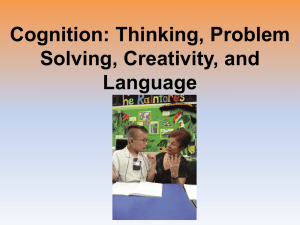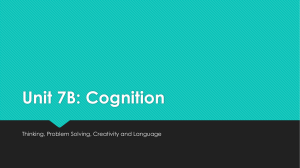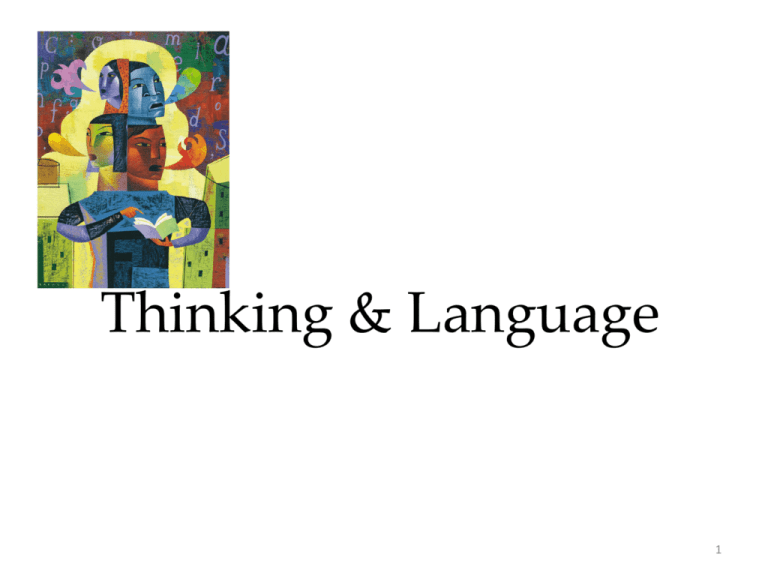
Thinking & Language
1
Thinking and Language
Thinking
Concepts
Solving Problems
Making Decisions and Forming
Judgments
Belief Bias
2
Thinking and Language
Language
Language Structure
Language Development
Thinking & Language
Language Influences Thinking
Thinking in Images
3
Thinking and Language
Animal Thinking and
Language
Do Animals Think?
Do Animals Exhibit Language?
The Case of the Apes
4
Thinking
Thinking, or cognition, refers to a process that
involves knowing, understanding,
remembering, and communicating.
5
Cognitive Psychologists
Thinking involves a number of mental
activities, which are listed below. Cognitive
psychologists study these in great detail.
1.
2.
3.
4.
Concepts
Problem solving
Decision making
Judgment formation
6
Concept
The mental grouping of similar objects, events, ideas, or
people. There are a variety of chairs but their common
features define the concept of a chair.
7
Category Hierarchies
We organize concepts into category hierarchies.
Courtesy of Christine Brune
8
Development of Concepts
We form some concepts with definitions. For
example, a triangle has three sides. Mostly, we
form concepts with mental images or typical
examples (prototypes). For example, a robin is
a prototype of a bird, but a penguin is not.
Bird (mental image)
J. Messerschmidt/ The Picture Cube
Daniel J. Cox/ Getty Images
Triangle (definition)
9
Categories
Once we place an item in a category, our
memory shifts toward the category prototype.
Courtesy of Oliver Corneille
A computer generated face that was 70 percent
Caucasian led people to classify it as Caucasian.
10
Problem Solving
There are two ways to solve problems:
Algorithms: Methodical, logical rules or procedures that guarantee
solving a particular problem.
11
Algorithms
Algorithms, which are very time consuming,
exhaust all possibilities before arriving at a
solution. Computers use algorithms.
SPLOYOCHYG
If we were to unscramble these letters to form a word
using an algorithmic approach, we would face
907,208 possibilities.
12
Heuristics
B2M Productions/Digital Version/Getty Images
Heuristics are simple,
thinking strategies
that allow us to make
judgments and solve
problems efficiently.
Heuristics are less
time consuming, but
more error-prone than
algorithms.
13
Heuristics
Heuristics make it easier for us to use simple
principles to arrive at solutions to problems.
SPLOYOCHYG
S
PP
SL
YO
CH
YO
OC
LH
OGY
Put a Y at the end, and see if the word
begins to make sense.
14
Insight
Insight involves a
sudden novel
realization of a
solution to a problem.
Humans and animals
have insight.
Grande using boxes to
obtain food
15
Insight
From Mark Jung-Beekman, Northwestern
University and John Kounios, Drexel University
Brain imaging and EEG
studies suggest that
when an insight strikes
(the “Aha” experience), it
activates the right
temporal cortex (JungBeeman, 2004). The time
between not knowing the
solution and realizing it
is 0.3 seconds.
16
Obstacles in Solving Problems
Confirmation Bias: A tendency to search for
information that confirms a personal bias.
2–4–6
Rule: Any ascending series of numbers. 1 – 2 – 3 would comply. Ss had
difficulty figuring out the rule due to a confirmation bias (Wason, 1960).
17
Fixation
Fixation: An inability to see a problem from a
fresh perspective. This impedes problem
solving. Two examples of fixation are mental set
and functional fixedness.
From “Problem Solving” by M. Scheerer. Copyright © 1963 by
Scientific American, Inc. All Rights Reserved.
The Matchstick
Problem: How would
you arrange six
matches to form four
equilateral triangles?
18
Candle-Mounting Problem
Using these materials, how would you mount the
candle on a bulletin board?
From “Problem Solving” by M. Scheerer. Copyright © 1963 by
Scientific American, Inc. All Rights Reserved.
19
The Matchstick Problem: Solution
From “Problem Solving” by M. Scheerer. Copyright © 1963 by
Scientific American, Inc. All Rights Reserved.
20
Candle-Mounting Problem: Solution
21
Mental Set
A tendency to approach a problem in a
particular way, especially if that way was
successful in the past.
22
Functional Fixedness
A tendency to think only of the familiar
functions of an object.
?
Problem: Tie the two ropes together.
Use a screw driver, cotton balls and a matchbox.
23
Functional Fixedness
Use the screwdriver as a weight, and tie it to the
end of one rope. Swing it toward the other rope
to tie the knot.
?
The inability to think of the screwdriver as a weight is
functional fixedness.
24
Using and Misusing Heuristics
Two kinds of heuristics, representative
heuristics and availability heuristics, have been
identified by cognitive psychologists.
Courtesy of Greymeyer Award, University
of Louisville and Daniel Kahneman
Courtesy of Greymeyer Award, University
of Louisville and the Tversky family
Amos Tversky
Daniel Kahneman
25
Representativeness Heuristic
Judging the likelihood of things or objects in
terms of how well they seem to represent, or
match, a particular prototype.
If you meet a slim, short, man who wears glasses and likes poetry,
Probability
thathis
person
is a truck
driver
what
do youthat
think
profession
would
be? is far greater than an ivy
league professor just because there are more truck drivers than such
professors.
An Ivy league professor or a truck driver?
26
Availability Heuristic
Why does our availability heuristic lead us astray?
Whatever increases the ease of retrieving
information increases its perceived availability.
How is retrieval facilitated?
1. How recently we have heard about the event.
2. How distinct it is.
3. How correct it is.
27
Making Decision & Forming
Judgments
Each day we make hundreds of judgments and
decisions based on our intuition, seldom using
systematic reasoning.
28
Overconfidence
Intuitive heuristics, confirmation of beliefs, and
the inclination to explain failures increase our
overconfidence. Overconfidence is a tendency to
overestimate the accuracy of our beliefs and
judgments.
At a stock market, both the seller
and the buyer may be confident
about their decisions on a stock.
29
Exaggerated Fear
The opposite of having
overconfidence is
having an exaggerated
fear about what may
happen. Such fears may
be unfounded.
AP/ Wide World Photos
The 9/11 attacks led to a
decline in air travel due
to fear.
30
Framing Decisions
Decisions and judgments may be significantly affected
depending upon how an issue is framed.
Example: What is the best way to market
ground beef — as 25% fat or 75% lean?
31
Belief Bias
The tendency of one’s preexisting beliefs to
distort logical reasoning by making invalid
conclusions.
God is love.
Love is blind
Ray Charles is blind.
Ray Charles is God.
Anonymous graffiti
32
Belief Perseverance
Belief perseverance is the tendency to cling to
our beliefs in the face of contrary evidence.
If you see that a country is hostile, you are likely
to interpret their ambiguous actions as a sign of
hostility (Jervis, 1985).
33
Perils & Powers of Intuition
Intuition may be perilous if unchecked, but
may also be extremely efficient and adaptive.
34
Perils & Powers of Intuition
35
Language
Language, our spoken, written, or gestured work,
is the way we communicate meaning to ourselves
and others.
M. & E. Bernheim/ Woodfin Camp & Associates
Language transmits culture.
36
Language Structure
Phonemes: The smallest distinct sound unit in a
spoken language. For example:
bat, has three phonemes b · a · t
chat, has three phonemes ch · a · t
37
Language Structure
Morpheme: The smallest unit that carries a
meaning. It may be a word or part of a word.
For example:
Milk = milk
Pumpkin = pump . kin
Unforgettable = un · for · get · table
38
Structuring Language
Phonemes
Basic sounds (about 40) … ea, sh.
Morphemes
Smallest meaningful units (100,000)
… un, for.
Words
Meaningful units (290,500) … meat,
pumpkin.
Phrase
Composed of two or more words
(326,000) … meat eater.
Sentence
Composed of many words (infinite)
… She opened the jewelry box.
39


